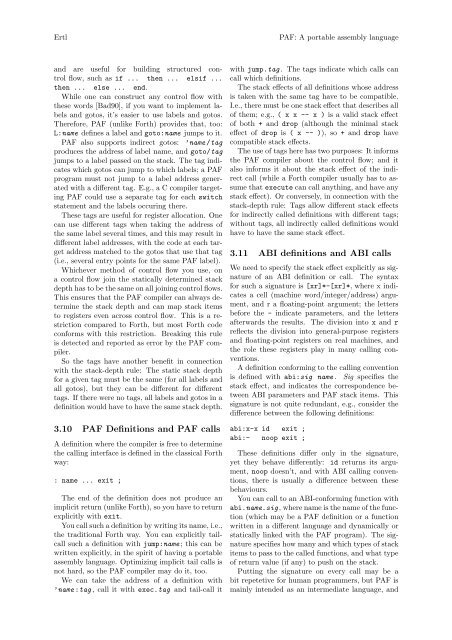ertl-paf
ertl-paf
ertl-paf
You also want an ePaper? Increase the reach of your titles
YUMPU automatically turns print PDFs into web optimized ePapers that Google loves.
ErtlPAF: A portable assembly languageand are useful for building structured controlflow, such as if ... then ... elsif ...then ... else ... end.While one can construct any control flow withthese words [Bad90], if you want to implement labelsand gotos, it’s easier to use labels and gotos.Therefore, PAF (unlike Forth) provides that, too:L:name defines a label and goto:name jumps to it.PAF also supports indirect gotos: ’name/tagproduces the address of label name, and goto/tagjumps to a label passed on the stack. The tag indicateswhich gotos can jump to which labels; a PAFprogram must not jump to a label address generatedwith a different tag. E.g., a C compiler targetingPAF could use a separate tag for each switchstatement and the labels occuring there.These tags are useful for register allocation. Onecan use different tags when taking the address ofthe same label several times, and this may result indifferent label addresses, with the code at each targetaddress matched to the gotos that use that tag(i.e., several entry points for the same PAF label).Whichever method of control flow you use, ona control flow join the statically determined stackdepth has to be the same on all joining control flows.This ensures that the PAF compiler can always determinethe stack depth and can map stack itemsto registers even across control flow. This is a restrictioncompared to Forth, but most Forth codeconforms with this restriction. Breaking this ruleis detected and reported as error by the PAF compiler.So the tags have another benefit in connectionwith the stack-depth rule: The static stack depthfor a given tag must be the same (for all labels andall gotos), but they can be different for differenttags. If there were no tags, all labels and gotos in adefinition would have to have the same stack depth.3.10 PAF Definitions and PAF callsA definition where the compiler is free to determinethe calling interface is defined in the classical Forthway:: name ... exit ;The end of the definition does not produce animplicit return (unlike Forth), so you have to returnexplicitly with exit.You call such a definition by writing its name, i.e.,the traditional Forth way. You can explicitly tailcallsuch a definition with jump:name; this can bewritten explicitly, in the spirit of having a portableassembly language. Optimizing implicit tail calls isnot hard, so the PAF compiler may do it, too.We can take the address of a definition with’name:tag, call it with exec.tag and tail-call itwith jump.tag. The tags indicate which calls cancall which definitions.The stack effects of all definitions whose addressis taken with the same tag have to be compatible.I.e., there must be one stack effect that describes allof them; e.g., ( x x -- x ) is a valid stack effectof both + and drop (although the minimal stackeffect of drop is ( x -- )), so + and drop havecompatible stack effects.The use of tags here has two purposes: It informsthe PAF compiler about the control flow; and italso informs it about the stack effect of the indirectcall (while a Forth compiler usually has to assumethat execute can call anything, and have anystack effect). Or conversely, in connection with thestack-depth rule: Tags allow different stack effectsfor indirectly called definitions with different tags;without tags, all indirectly called definitions wouldhave to have the same stack effect.3.11 ABI definitions and ABI callsWe need to specify the stack effect explicitly as signatureof an ABI definition or call. The syntaxfor such a signature is [xr]*-[xr]*, where x indicatesa cell (machine word/integer/address) argument,and r a floating-point argument; the lettersbefore the - indicate parameters, and the lettersafterwards the results. The division into x and rreflects the division into general-purpose registersand floating-point registers on real machines, andthe role these registers play in many calling conventions.A definition conforming to the calling conventionis defined with abi:sig name. Sig specifies thestack effect, and indicates the correspondence betweenABI parameters and PAF stack items. Thissignature is not quite redundant, e.g., consider thedifference between the following definitions:abi:x-x id exit ;abi:- noop exit ;These definitions differ only in the signature,yet they behave differently: id returns its argument,noop doesn’t, and with ABI calling conventions,there is usually a difference between thesebehaviours.You can call to an ABI-conforming function withabi.name.sig, where name is the name of the function(which may be a PAF definition or a functionwritten in a different language and dynamically orstatically linked with the PAF program). The signaturespecifies how many and which types of stackitems to pass to the called functions, and what typeof return value (if any) to push on the stack.Putting the signature on every call may be abit repetetive for human programmers, but PAF ismainly intended as an intermediate language, and


